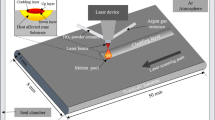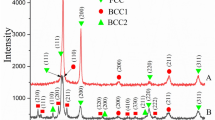Coatings of (Ti, Cr)B2–NiAlCr cermet materials were deposited on structural steel substrates by detonation spraying. The optimal spray conditions depending on the ratio of structural components were determined for the materials developed. The effect exerted on the coating microstructure and composition by the content of refractory and metal components in the sprayed material was examined. A heterophase lamellar microstructure with the phases being distributed quite uniformly was formed. Coatings from materials with a greater content of the metal component have more uniform phase distribution, which largely depends on the process characteristics of the powders. The NiAlCr alloy-base powders have three to four times higher flowability than the (Ti, Cr)B2-base powders, promoting more stable powder supply and spray process as a whole. The coatings thus show higher density and more uniform phase distribution. Various coating structures were analyzed: without a sublayer, with a NiCr detonation-sprayed sublayer, and with an electrospark-deposited sublayer produced from the same material as used for the main coating. The resultant coatings have high-quality adhesive contact with the substrate, both with and without a NiCr detonation sublayer, and their thicknesses can reach 0.8–1 mm. When an electrospark-deposited sublayer with a high (Ti, Cr)B2 content was used, cracks were found at the coating–sublayer interfaces. This is due to higher hardness and lower ductility of the sublayer under the action of accelerated spray particles. Preliminary surface treatment by spraying different types of sublayers hardly influences the microstructure of the coatings and the quality of their contact with the substrate.









Similar content being viewed by others
References
S.S. Bartenev, Yu.P. Fedko, and A.I. Grigorov, Detonation Coatings in Mechanical Engineering [in Russian], Mashinostroenie, Leningrad (1982), p. 215.
A.I. Zverrev, E.A. Astakhov, and S.Yu. Sharivker, Detonation Spraying of Coatings [in Russian], Sudostroenie, Leningrad (1979), p. 232.
E.A. Astakhov, “Controlling the properties of detonation-sprayed coatings: Major aspects,” Powder Metall. Met. Ceram., 47, No. 1–2, 70–79 (2008).
Yu.A. Nikolaev, A.A. Vasiliev, and V.Yu. Ulianitskii, “Gas detonation and its application in engineering and technology (overview),” Fiz. Gor. Vzryv., 39, No. 4, 22–54 (2003).
V.V. Shchepetov and A.M. Volkhov, “Increase in the wear resistance of detonation-sprayed coatings through optimization of depositions conditions,” Tren. Iznos, No. 5, 844–848 (1990).
G.V. Samsonov, T.I. Serebriakova, and V.A. Neronov, Borides [in Russian], Atomizdat, Moscow (1975), p. 366.
M. Bengisu, Engineering Ceramics, Springer-Verlag, Berlin–Heidelberg (2001), p. 620.
B. Basu, J.B. Ragu, and A.K. Suri, “Processing and properties of monolithic TiB2 based materials,” Int. Mater. Rev., 51, No. 6, 352–374 (2006).
V.P. Konoval, V.Zh. Shemet, B. Gruszko, A.D. Panasyuk, T.V. Mosina, and V.I. Subbotin, “Structure and properties of titanium–chromium diboride composites,” Powder Metall. Met. Ceram., 51, No. 7–8, 429– 436 (2012).
I.A. Podchernyaeva, E.A. Astakhov, A.P. Umanskii, A.D. Panasyuk, V.P. Konoval, and V.M. Panashenko, “Structure and phase composition of composite detonation coatings based on TiCrB2 and ZrB2,” Powder Metall. Met. Ceram., 49, No. 5–6, 295–303 (2010).
V.P. Konoval, V.V. Akopyan, O.D. Kostenko, K.N. Galtsov, and T.V. Mosina, “Mechanical and tribotechnical properties of detonation-sprayed titanium–chromium carbide coatings,” Dop. Nats. Akad. Nauk Ukrainy, No. 4, 77–82 (2015).
I.A. Podchernyaeva, V.V. Shchepetov, A.D. Panasyuk, V.Yu. Gromenko, D.V. Yurechko, and V.P. Katashinskii, “Structure and properties of wear-resistant detonation coatings based on titanium carbonitride,” Powder Metall. Met. Ceram., 42, No. 9–10, 497–502 (2003).
V.P. Konoval, O.P. Umanskii, A.D. Panasyuk, and O.F. Lukyanchuk, “Effect of the chemical composition of electrode materials and deposition parameters on the properties of electrospark-deposited coatings. I. Mass transfer rate and coating composition,” Powder Metall. Met. Ceram., 53, No. 1–2, 31–39 (2014).
V.P. Konoval, O.P. Umanskii, O.D. Kostenko, and I.S. Martsenyuk, “Effect of the chemical composition of electrode materials and deposition parameters on the properties of electrospark-deposited coatings. ІІ. Coating hardness and wear resistance,” Powder Metall. Met. Ceram., 53, No. 3–4, 210–218 (2014).
GOST 18318–94. Metallic Powders. Determination of Particle Sizes by Dry Sieving [in Russian], Izdatelstvo Standartov (1996).
GOST 20899–98. Metallic Powders. Determination of Flowability by a Calibrated Funnel (Hall Flowmeter) [in Russian], Izdatelstvo Standartov (2001).
GOST 19440–94. Metallic Powders. Determination of Apparent Density. Part 1. Funnel Method [in Russian], Izdatelstvo Standartov (1996).
V.Yu. Ulianitskii, A.A. Shtertser, S.B. Zlobin, Rao D. Srinivasa, and G. Sundararajan, “Structure and tribotechnical properties of detonation-sprayed wear-resistant coatings,” Fiz. Mezomekh., 9, No. 4, 87–92 (2006).
P.A. Vityaz, A.F. Ilyushchenko, and A.I. Shevtsov, Fundamentals of Depositing Wear-Resistant, Corrosion-Resistant, and Thermal-Barrier Coatings [in Russian], Belorusskaya Nauka, Minsk (2006), p. 363.
Lakhwinder Singh, Vikas Chawla, and J. S. Grewal, “A review on detonation gun sprayed coatings,” J. Mineral. Mater. Charact. Eng., 11, No. 3, 243–265 (2012).
A.L. Borisova, L.I. Adeev, A.Yu. Tunik, T.V. Kaida, A.F. Ilyushchenko, and A.V. Belyaev, “Structure and properties of thermal spray coatings from titanium carbide and titanium–chromium oxides containing solid lubricants,” Avtomat. Svarka, No. 1, 22–28 (1999).
O.P. Umanskyi, M.S. Storozhenko, M.V. Koshelev, M.A. Vasylkivska, and I.I. Tymofeeva, “Effect of FeNiCrBSiC–MeB2 material composition on the oxidation behavior at high temperatures,” Powder Metall. Met. Ceram., 57, No. 11–12, 670–678 (2019).
J. Keranen, T. Stenberg, T. Mantyla, and T. Lepisto, “Microstructural characterization of detonation gun sprayed boride-based cermet coatings,” Surf. Coat. Technol., 82, No. 1–2, 29–37 (1996).
Author information
Authors and Affiliations
Corresponding author
Additional information
Translated from Poroshkova Metallurgiya, Vol. 59, Nos. 5–6 (533), pp. 92–106, 2020.
Rights and permissions
About this article
Cite this article
Konoval, V., Umanskyi, O., Bondarenko, O. et al. Detonation-Sprayed Coatings of (Ti, Cr)B2–NiAlCr Composite Materials I. Deposition Technique and Composition and Microstructure of Coatings. Powder Metall Met Ceram 59, 308–317 (2020). https://doi.org/10.1007/s11106-020-00164-3
Received:
Published:
Issue Date:
DOI: https://doi.org/10.1007/s11106-020-00164-3




